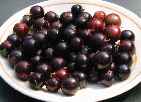Categories
Calendars
Guides
Reviews
Archive
Gallery
Articles
Ask Our Gardening Expert
Growing Blackcurrants
Blackcurrants
An
easy crop to grow in the garden, they are however expensive in the supermarkets.
Home grown, they are almost free and packed full of vitamins,
especially vitamin C.
BLACKCURRANT
QUICK GUIDE Latin Name Type Site and Soil Plant to Harvest Time Yield Varieties of Blackcurrant
Variety
Type
Comments
Ben Gairn
Early
Resistant to most diseases affecting blackcurrants
including Reversion virus. One of the earliest varieties to fruit
, it has medium sized berries with a good taste.
Ben Lomond
Mid-season
Titania
Mid-season
Large tasty blackcurrants on a tallish bush. Needs
a protected position. Good disease resistance.
If you want to buy Ben Lomond from our
recommended suppliers, then
click here Site
and Soil For Blackcurrants Their ideal site is in full sun, but the effect of partial shade does them
little harm. Avoid frost-pockets, their flowers can be damaged by a late
frost which will of course result in a lower yield of fruit. Their ideal soil is a rich well-drained soil which will not dry out. They
prefer a slightly acidic soil - around pH 6 to 6.5 (click here
for more
details on soil acidity). They will grow well however on most normal soils.
Blackcurrants were traditionally used only for jams, pies and
puddings, and they tasted great. More
recently, there are varieties the size of small grapes which are
tasty eaten by themselves, with ice cream or cream. Mixed with
other fruit, they are delicious.
 Blackcurrants
the size of small grapes with a taste to match.
Blackcurrants
the size of small grapes with a taste to match.
Ribes nigrum
Hardy deciduous shrub with edible berries
Tolerant of many conditions. Preferably full sun, on a rich well-drained soil.
2 years
4kg (9lb) per bush
The table below lists varieties recommended by GardenAction.
Resistant
to most foliar diseases and also to mildew. This variety grows
to around 1 metre (3 foot) high and produces large fruit. Superb taste, the best in
our opinion.
Blackcurrants are more tolerant than many fruits of their site and soil
conditions. What they do like though is a moist soil, but not water
logged. They need the moisture for the fruits to develop. This is one
reason why they do well in less dry parts of the UK.
Name: don
E-mail: d_lefurgey@hotmail.com
Date posted: June 20, 2011 - 11:49 am
Message: forgot to add email.
Name: Don
E-mail: Private
Date posted: June 20, 2011 - 11:45 am
Message: I've had black berry bushes for three years now. I've had lots of blossoms, but the last two years they have fallen off and I get no fruit. Could someone help me to find out why the blossoms fall off. Thank you.
Name: Captain Ramsey
E-mail:
Date posted: May 09, 2011 - 06:11 pm
Message: Black Currants will grow 1-2 metres in height, or roughly 3.2-6.4 feet.
I assume Red Currants are similar.
A Gooseberry Bush can apparently grow anywhere from 3-10 feet.
Name: sarah
E-mail: Private
Date posted: May 03, 2011 - 04:06 pm
Message: hi I recently bought several fruit bushes(gooseberry,tayberry,redcurrent and blackcurrent).we want to build a fruit cage around to stop the local wildlife devouring or bounty but cant seem to find what height any of these bushes will grow to.can anybody help.sarah
Name: Saundra
E-mail: shapeshifterhyro@hotmail.com
Date posted: August 27, 2010 - 03:29 am
Message: Hi. I discovered what looks like a blackcurrent bush on a forest trail in southern B.C. The leaves and all-over shape of the bush look similar to current bushes I'm familiar with but the branches of the bush itself are covered with sharp tiny prickles, so I am wondering if this is a true currant or what other type of fruit- bearing shrub it might be. As it has grown in a fairly dense area and gets little sun there were not many berries on it, and the few there were were quite small, but black as blackcurrants are. Anything insight you may have into what this might be would be very much appreciated.
Thank you,
Saundra